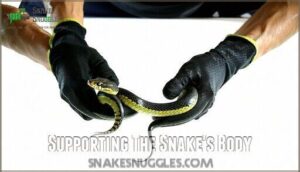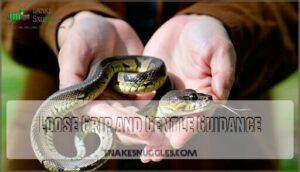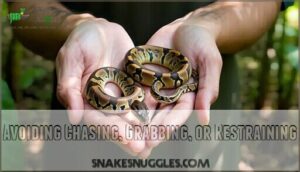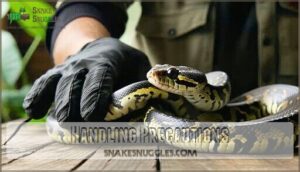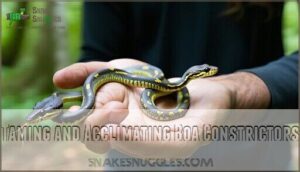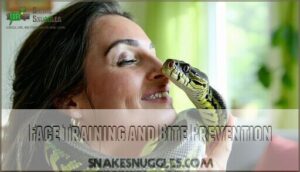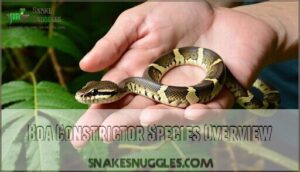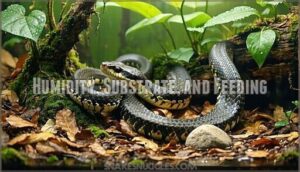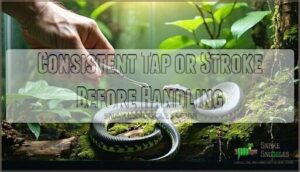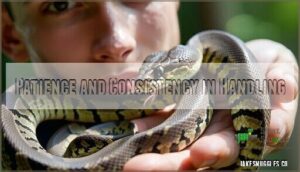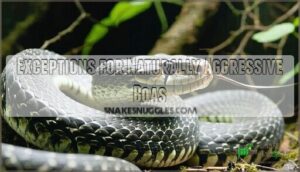This site is supported by our readers. We may earn a commission, at no cost to you, if you purchase through links.
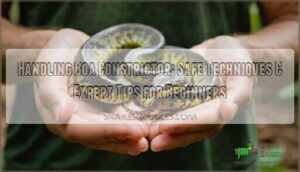 When handling boa constrictor, you’re working with a surprisingly gentle giant that’s more likely to cuddle than strike.
When handling boa constrictor, you’re working with a surprisingly gentle giant that’s more likely to cuddle than strike.
Support their muscular body with both hands, never grabbing or restraining them like you’re wrestling a fire hose. Move slowly and confidently—boas can sense your energy.
Watch for stress signals like rigid posturing or hissing, which means "not today, human." Start with short sessions and gradually build trust.
Think of it as a dance where the snake leads and you follow. Most bites happen when handlers rush or panic, not because boas are aggressive. The secret lies in reading their body language and mastering specific techniques that turn nervous beginners into confident handlers.
The key to successful handling is to approach the interaction with patience and understanding, allowing the boa to set the pace and dictate the terms of the encounter, which is essential for building a strong and trusting relationship with these gentle giants.
Table Of Contents
- Boa Constrictor Behavior and Temperament
- Proper Handling Techniques
- Handling Precautions
- Taming and Acclimating Boa Constrictors
- Face Training and Bite Prevention
- Boa Constrictor Species Overview
- Boa Constrictor Housing Requirements
- Temperature and Lighting for Boa Constrictors
- Humidity, Substrate, and Feeding
- Tap Training and Handling Challenges
- Frequently Asked Questions (FAQs)
- How do you tame a boa constrictor?
- How do you care for a boa constrictor snake?
- Are boa constrictors safe?
- Who are boa constrictors suitable for as pets?
- How do you handle a boa?
- Do boa constrictors require a hook for handling?
- Do boa constrictors like to be handled?
- Is it safe to hold a boa constrictor?
- How often should you handle your boa constrictor?
- What to do if a boa is constricting you?
- Conclusion
Boa Constrictor Behavior and Temperament
Understanding your boa’s personality before you handle it can save you from a surprise wrestling match with 8 feet of muscle.
Know your boa’s mood before reaching in—nobody wants to tango with a grumpy 8-foot muscle rope.
You’ll notice each boa has its own temperament, from laid-back couch potatoes that barely flinch when touched to defensive drama queens that hiss and coil into tight balls at the first sign of human interaction.
The variation in temperament is significant, ranging from laid-back individuals to those that are more defensive.
Defensive Behavior in Vivarium
Most boa constrictors exhibit defensive behavior when they feel threatened in their snake enclosure. Your snake’s temperament variation means some individuals show more enclosure aggression than others.
Watch for these key stress indicators that signal handling avoidance:
- Coiling tightly into a defensive ball
- Raising head in an S-shaped strike position
- Hissing with mouth open wide
- Rapid tongue flicking and darting movements
- Retreating to hide spots immediately
Understanding these stress signs helps you read your snake’s mood like a book. Environmental enrichment can reduce defensive responses over time.
Twitchy Movements and Rigid Body
Stress indicators reveal themselves through your boa’s body language before any dramatic defensive moves occur.
Watch for twitchy movements and rigid posturing—these discomfort signals mean your snake’s on high alert.
Rapid, stiff tongue flicking replaces the usual relaxed exploration pattern.
| Relaxed Behavior | Stressed Behavior |
|---|---|
| Smooth, flowing movement | Jerky, twitchy motions |
| Casual tongue flicking | Rapid, stiff tongue darts |
| Loose body posture | Rigid, tense positioning |
Reading these defensive postures prevents stressful handling irritability situations.
Striking and Hissing
Imagine this: your normally calm boa suddenly transforms into a coiled spring ready to launch. Striking and hissing represent peak defensive behavior – your snake’s final warning before potential snake bite.
When your gentle giant becomes a coiled spring, it’s screaming "back off" in snake language.
Here are five critical stress signals indicating snake aggression:
- Rapid tongue flicking – like a smoke detector going off
- S-shaped coiling – the classic snake striking position
- Loud hissing sounds – your boa’s alarm system
- Mouth gaping wide – showing those impressive teeth
- Rearing back motion – preparing for defensive posture
When you spot these threat displays, back away immediately. Temperament variations mean some boas show snake defensive behavior more readily than others. This isn’t personal – it’s pure instinct. Handling avoidance during these moments prevents escalation and keeps everyone safe. Your boa’s telling you loud and clear: "Not today, human."
Remember, defensive postures aren’t aggression – they’re communication. Respect these stress signals, and you’ll build trust over time. Even the most defensive snake can learn you’re not a threat with patience and proper technique.
Proper Handling Techniques
When you’re ready to handle your boa constrictor, think of yourself as a living tree branch rather than a grabbing predator – you’ll support the snake’s body weight with both hands while allowing it to move naturally around you.
Your goal isn’t to control every movement but to provide gentle guidance with a loose grip, letting the snake feel secure enough to explore without triggering its defensive instincts, allowing it to move with a sense of natural security.
Supporting The Snake’s Body
When you handle your boa, think of yourself as a living tree branch.
Place one hand behind the head and another supporting the middle third of its body.
This weight distribution prevents spine damage and gives your snake the coiling support it craves.
Your grip strength should be firm but relaxed—imagine holding a water balloon.
Proper snake support means letting the boa wrap naturally around your arms for snake stability, creating a secure foundation that prevents injury to both of you during snake handling techniques.
Loose Grip and Gentle Guidance
Most successful boa constrictor handling starts with a relaxed approach—think of it like holding a garden hose, not gripping a baseball bat.
Your hands should provide secure support without creating tension that’ll stress your snake.
Watch their body language carefully; if they’re moving in one direction, gently guide them rather than forcing a different path.
Prevent neck wrapping by softly redirecting their head when needed.
This guiding movement technique keeps both you and your boa comfortable during safe snake handling sessions, building trust through consistent, gentle snake handling techniques.
Avoiding Chasing, Grabbing, or Restraining
Building on gentle guidance techniques, your boa constrictor handling success depends on avoiding three critical mistakes.
Never chase, grab, or restrain your snake – these actions trigger defensive responses and feeding behaviors that can lead to bites. Instead, let your boa move naturally while providing body support through slow movements and a loose grip.
Think of it like dancing with a partner who leads – you follow their rhythm rather than forcing your own. Boas comfort comes from feeling secure, not trapped.
When you maintain gentle handling practices, your snake stays relaxed and predictable.
- Never corner your boa – trapped snakes become defensive quickly
- Avoid sudden movements that startle and stress your snake
- Use patience over force – stressed boas are more likely to bite
- Remember proper snake safety – gentle handling prevents accidents and injuries
Handling Precautions
You’ll need to avoid handling your boa during certain times to prevent stress and potential injury to both you and your snake.
Think of it like respecting someone’s personal space when they’re having a bad day—your boa will show clear signals when it’s not in the mood for interaction, and ignoring these cues can lead to defensive behavior or even a bite.
You’ll need to avoid handling your boa during certain times to prevent stress and potential injury to both you and your snake.
Think of it like respecting someone’s personal space when they’re having a bad day—your boa will show clear signals when it’s not in the mood for interaction, and ignoring these cues can lead to defensive behavior or even a bite.
handling-precautions-intro
text/markdown
Handling Precautions Introduction
You’ll need to avoid handling your boa during certain times to prevent stress and potential injury to both you and your snake.
Think of it like respecting someone’s personal space when they’re having a bad day—your boa will show clear signals when it’s not in the mood for interaction, and ignoring these cues can lead to defensive behavior or even a bite.
Avoiding Handling During Specific Conditions
Timing matters when handling your boa constrictor.
Never handle during the shedding cycle when they’re "in blue" or for 48 hours post-feeding while digesting.
Skip handling new arrivals for at least a week until they settle in.
Watch for defensive postures like hissing or tight coiling – these snake stress signals mean back off.
Health concerns and snake scent confusion can also trigger defensive behaviors, so respect these snake handling safety guidelines.
Handling Large Boas With Assistance
Large boas over six feet require teamwork for safe boa constrictor handling.
Two-person assisted handling benefits both you and your snake through proper weight distribution and enhanced safety protocols.
Here’s your partner communication strategy:
- Primary handler supports the head and front third of the body
- Secondary handler manages the middle and rear sections
- Both handlers maintain constant communication during movement
This approach prevents emergency scenarios while ensuring your snake feels secure.
Think of it as a dance – when both partners know their steps, everyone stays comfortable and safe.
Respecting The Snake’s Signals
Reading body language helps you recognize when your boa isn’t in the mood for handling.
Watch for defensive postures like tight coiling, hissing, or rearing up—these are clear stress indicators saying "back off."
Each snake has temperament variations, from docile to naturally nervous.
Understanding snake behavior means respecting these handling boundaries.
When tension builds, give your snake space to decompress.
Taming and Acclimating Boa Constrictors
Taming and acclimating your boa constrictor requires patience and consistency, much like earning trust from a shy friend who needs time to warm up to you.
You’ll start with brief 5-minute handling sessions every few days, gradually increasing both duration and frequency as your snake becomes more comfortable with human interaction and learns that you’re not a threat, which helps in acclimating your boa constrictor.
Gradual Increase in Handling Time and Frequency
After understanding proper precautions, you can begin taming your boa constrictor with patience and consistency. Start with brief 5-minute sessions every few days, gradually building trust through positive experiences.
Your snake will recognize these handling sessions as safe interactions, reducing stress over time.
Smart taming involves reading your boa’s behavioral cues and adjusting accordingly:
- Session Duration: Begin with 5 minutes, increase to 15 minutes by week six
- Handling Frequency: Start every 3-4 days, progress to 1-2 times weekly
- Taming Benefits: Reduces defensive behaviors and builds human-snake trust
- Stress Reduction: Consistent gentle handling creates predictable, calming routines
Remember, snake handling mastery comes through repetition, not rushing.
Consistent, Gentle Handling for Docile Adults
After increasing your handling frequency, building trust with docile adult boas requires gentle consistency.
Handle your boa constrictor 1-2 times weekly, keeping sessions under 15 minutes to prevent stress.
Watch their body language closely – relaxed coiling around your arms shows comfort.
Avoid startling movements and support their weight fully.
This patient approach transforms even nervous snakes into calm companions through proper reptile handling techniques.
Lightly Touching The Snake’s Head
During the trust-building process, you’ll eventually progress to lightly touching your boa’s head—a pivotal milestone in snake handling.
This gentle contact helps with signaling handling time while reducing stress through consistent interaction.
Here’s your head-touching roadmap:
- Start with brief, feather-light touches using your fingertip
- Watch for defensive postures like hissing or pulling away
- Practice consistent tapping before each session to establish trust
- Never grab or restrain—think "butterfly landing" gentle
This snake handling technique transforms skittish boas into confident companions.
Remember, avoiding bites starts with respecting boundaries.
Your boa constrictor will appreciate the gradual approach, and you’ll become a skilled pet snake handling expert.
Snake handler head caution pays off when your snake handling tips include patience over pressure.
Face Training and Bite Prevention
Teaching your boa that your face isn’t a snack might sound odd, but face training helps prevent those awkward moments when your snake mistakes your nose for dinner.
You’ll guide your boa to explore your facial features safely while watching for signs of tension or rapid tongue flicking that signal it’s time to redirect their attention elsewhere, which is crucial for a harmonious and safe interaction.
Allowing The Snake to Climb on Your Face
Face training involves letting your boa constrictor explore your facial features to reduce bite risk and build trust.
This controversial technique helps snakes recognize human faces aren’t food, improving snake handling safety.
However, facial safety concerns and hygiene issues make this risky for beginners.
Before handling, remember to wash your hands.
Consider training alternatives like hand contact first, and always prioritize snake safety precautions over dramatic boa constrictor bonding methods to ensure dramatic boa constrictor bonding is done safely.
Interrupting Rapid Tongue Flicking or Tension
During face training sessions, you’ll need to watch your boa’s body language like a hawk. Rapid tongue flicking and muscle tension signal stress that requires immediate intervention.
These warning signs mean your snake’s nervousness is escalating, and continuing could trigger defensive behavior. Understanding snake behavior helps you recognize when environmental factors or handling duration overwhelm your boa’s individual temperament.
Snakes use their tongues to sample chemical gradients, allowing them to perceive their surroundings.
Apply these calming techniques for effective stress reduction:
- Slowly back away without sudden movements
- Lower your voice to reduce stimulation
- Gently place the snake on a secure surface
Following proper snake handling guidelines prevents escalation.
Avoiding Punishment After a Bite
When your boa bites, resist the urge to yell or jerk away. Bite reinforcement happens when you react dramatically – the snake learns that biting gets results. Instead, maintain a calm reaction and gently pull the snake toward you for dislodging bites.
Their rearfacing teeth can cause teeth ripping if you pull backward, creating unnecessary pain association.
| Bite Response | Wrong Approach | Right Approach |
|---|---|---|
| Initial Reaction | Yelling, jerking away | Stay calm, breathe deeply |
| Dislodging Method | Pull snake away from you | Gently pull toward yourself |
| After-Bite Action | Return snake immediately | Continue brief handling session |
| Snake bite treatment | Ignore wound care | Clean with soap and water |
| Future Prevention | Avoid handling completely | Analyze what triggered bite |
Proper hygiene practices include washing the bite area thoroughly – boa mouths harbor bacteria that can cause infection. Don’t let one snake bite derail your progress.
Most bites happen during feeding confusion or when the snake feels threatened. Learn from the experience rather than creating negative associations that’ll make future handling sessions more challenging.
Boa Constrictor Species Overview
Before you can handle your boa constrictor safely, you’ll need to understand what you’re working with—these impressive snakes belong to the species Boa constrictor and can grow quite large, with females reaching 7-10 feet and males typically staying around 6-8 feet long.
Think of it like knowing whether you’re adopting a golden retriever or a great dane; size matters when you’re planning to pick up your new scaly friend, especially since these beauties can live 20-30 years and will be your handling partner for decades.
Common Names and Scientific Names
Beyond face training lies understanding your snake’s identity.
Boa constrictors carry the scientific name Boa constrictor, with two main subspecies from Central and South America.
You’ll hear terms like Colombian boa or redtailed boa – these regional names reflect their origins.
Boa taxonomy gets complex with morph variations and captive breeding, but species identification starts with knowing these fundamental name origins that connect your pet to its wild heritage.
The boa genus includes three species, each uniquely adapted to different habitats.
These snakes are heavy-bodied, with adults often reaching lengths of 8-10 feet.
Adult Size and Life Expectancy
Understanding your future companion’s dimensions matters before bringing one home.
Boa constrictor size varies dramatically – females typically stretch 7-10 feet while males stay smaller at 6-8 feet.
This sexual dimorphism means choosing gender affects space needs.
Their lifespan spans 20-30 years, making them a serious longterm commitment requiring decades of dedication.
Here’s what shapes your boa’s size variation and longevity records:
- Growth rate peaks during the first three years, then gradually slows as adult snakes reach maturity
- Lifespan factors include proper nutrition, consistent veterinary care, and ideal environmental conditions throughout their lives
- Snake size variations depend heavily on locality – some populations naturally grow larger than others
- Snake longterm commitment means planning for housing upgrades as juveniles become impressive adults requiring larger enclosures
Boa Constrictor Housing Requirements
You’ll need a spacious enclosure that’s at least as long as your boa, with adult snakes requiring a minimum of 72" x 24" x 24" to stretch out and move comfortably.
Think of it like setting up a studio apartment for your snake – they need hiding spots for privacy, sturdy branches for climbing adventures, and enough room to feel secure while you’re building that trust for safe handling sessions.
Enclosure Size and Dimensions
Your boa deserves room to stretch out comfortably. These powerful constrictors need spacious homes that match their impressive size. Getting the dimensions right prevents stress and promotes healthy behavior.
| Snake Size | Minimum Dimensions | Notes |
|---|---|---|
| Baby (under 2′) | 2’L x 1.5’W x 1’H | Starter enclosure |
| Juvenile (2-5′) | 4’L x 2’W x 2’H | Growth phase |
| Adult (6-8′) | 6’L x 3’W x 3’H | Standard adult |
| Large Adult (8’+) | 8’L x 4’W x 4’H | Maximum comfort |
| All Sizes | Full body length | Exercise space |
Proper boa constrictor care means providing adequate vertical space and room for natural movement patterns. Maintaining proper humidity levels is also essential for healthy shedding.
Hiding Spots and Perches
Your snake enclosure needs more than just space—it craves security and enrichment. Think of your boa’s tank decor as creating a reptilian apartment with all the essentials.
Essential hiding spots and climbing opportunities include:
- Two secure hides: Place one on the warm side, another on the cool side (slightly larger than your snake’s body)
- Sturdy tree branch or driftwood: Sterilized perch materials for climbing and resting
- Spatial complexity: Multiple levels and textures to mimic natural habitat
These elements transform a basic snake enclosure into a comfortable home where your boa feels safe and confident. Consider also the importance of quality reptile enclosures for your boa.
Cleaning and Disinfection
After setting up proper hiding spots and perches, maintaining enclosure sanitation becomes your next priority.
You’ll want to establish a cleaning frequency that includes daily waste removal and weekly deep cleaning with reptile-safe disinfectants.
Spot cleaning prevents pathogens from building up, while thorough disinfection keeps your boa healthy.
Remember—proper reptile hygiene starts with your hands before and after every interaction.
Temperature and Lighting for Boa Constrictors
You’ll need to maintain precise temperatures and lighting to keep your boa constrictor healthy and comfortable, just like setting up a tropical vacation spot in their enclosure.
Getting the temperature gradient right between 82-90°F during the day and 78-85°F at night, with a 95°F basking spot, helps your snake regulate its body temperature naturally and reduces stress during handling sessions.
Optimal Daytime and Nighttime Temperatures
Maintaining the right temperature gradient is essential for your boa constrictor care.
Keep daytime temperatures between 82-90°F and nighttime at 78-85°F.
This natural drop mimics their wild habitat and aids digestion.
Use quality heating methods with thermostat control and reliable thermometers.
Your snake’s health depends on consistent monitoring—think of yourself as their personal climate controller!
Basking Spot Temperature
Your boa’s basking area needs to hit that sweet spot of 90-95°F – think of it as your snake’s personal sauna.
This temperature gradient lets your boa regulate its body temperature naturally, especially after meals when digestion kicks into high gear.
Here’s what makes a perfect basking setup:
- Position the heat source at one end, creating a natural gradient across the enclosure
- Surface temperatures should run warmer than air temps for optimal temperature control
- Your boa will choose when and how long to bask based on its needs
Heating Equipment and Thermometers
Choosing the right heat sources transforms your boa constrictor into a content, healthy pet.
Halogen bulbs create natural basking spots, while ceramic heaters maintain nighttime warmth. Deep Heat Projectors offer excellent temperature gradient control for enclosure setup.
| Equipment Type | Best Use | Temperature Range |
|---|---|---|
| Halogen Bulbs | Daytime basking | 86-90°F surface |
| Ceramic Heaters | Nighttime heating | 75-80°F ambient |
| Deep Heat Projectors | All-day heating | 82-90°F gradient |
| Heat Mats | Belly heat | 85-88°F surface |
| Digital Thermostats | Thermostat control | Precise regulation |
Digital thermometers with probes give accurate temperature monitoring. Place sensors at cool and warm ends for proper thermostat management.
Consider specialized heat products for ideal temperature regulation. Your snake’s comfort depends on consistent, reliable heating that mimics their natural habitat perfectly.
Humidity, Substrate, and Feeding
You’ll need to maintain proper humidity levels between 50-70%, choose the right substrate like aspen shavings or cypress mulch, and establish a feeding schedule that matches your boa’s age and size.
Getting these three environmental factors right isn’t just about creating a comfortable home—it’s about ensuring your snake stays healthy enough to handle safely, since stressed or unhealthy boas can become unpredictable during interactions, which is crucial for maintaining a safe and unpredictable environment.
Ideal Humidity Range
With temperatures stable, humidity control becomes your next priority.
Think of it as creating a tropical vacation spot for your boa. Proper moisture levels prevent shedding issues and respiratory infections while supporting long-term snake health.
Here’s your humidity monitoring game plan:
- Target 55-75% humidity using digital hygrometers for accurate readings
- Boost levels to 75-85% during shedding periods for easier skin removal
- Use misting techniques like large water bowls and spray systems for hydration methods
- Monitor daily since consistent snake husbandry prevents costly vet visits later
Suitable Substrate Options
Your boa’s foundation matters more than you’d think.
Aspen shavings, cypress mulch, and coconut coir top the list for excellent moisture retention and easy cleaning. These granular substrates maintain proper humidity without creating bacterial breeding grounds.
Products for reptile care are widely available online.
Bioactive substrates like Terra Firma offer natural waste processing. Maintain 2-3 inches substrate depth for burrowing species.
Skip reptile carpet and cedar—they’re problematic for respiratory health and humidity control.
Feeding Frequency and Prey Size
Your boa’s appetite changes as it matures. Juvenile feeding requires appropriately-sized prey items every 7 days, while adult intervals stretch to 10-14 days.
The golden rule: prey girth shouldn’t exceed your snake’s widest point. Frozen thawed prey is safer than live feeding, reducing injury risk.
Whether you’re feeding young boas mice or offering adults rabbits, proper boa constrictor feeding schedules and correctly-sized snake food prevent regurgitation and keep your serpent healthy.
Tap Training and Handling Challenges
You’ll need to tap your boa’s head with a snake hook or paper towel roll before each handling session to signal it’s time for interaction, not feeding—think of it as knocking before entering someone’s room.
Building trust through consistent, patient handling takes weeks or months, and while most boas become docile with regular practice, some individuals remain naturally defensive despite your best efforts to establish a connection, which is crucial for trust.
Consistent Tap or Stroke Before Handling
One simple technique transforms your boa constrictor from defensive to docile: consistent tapping.
Before each handling session, gently tap or stroke your snake’s body with a hook or similar tool. This signaling handling approach breaks the feeding response and creates a positive association with human contact.
Your consistent routine teaches proper snake behavior expectations while reducing stress and avoiding bites.
Don’t tap scared snakes on the head—this worsens defensive reactions. Instead, focus on the last half of the body using slow, even movements for effective snake handling techniques.
Patience and Consistency in Handling
Building successful snake handling requires gradual introduction and unwavering snake patience.
Start with 5-minute session duration every few days, then slowly increase to 10-15 minutes daily.
This handling frequency accommodates temperament variation while building trust.
Consistent, gentle interaction transforms defensive juveniles into calm adults.
Snake respect and snake understanding create the foundation for lifelong snake temperament success through patience.
Exceptions for Naturally Aggressive Boas
Some boas naturally exhibit aggressive tendencies despite consistent handling efforts. Understanding snake temperament and snake defensive behaviors helps you recognize when specialized equipment or experienced handlers become necessary.
Snake aggression management requires patience, but bite possibility remains real with defensive animals. Proper husbandry can help reduce defensive behaviors.
When facing persistent aggression causes, consider these handling alternatives:
- Consult experienced handlers for temperament modification techniques
- Use specialized equipment like longer hooks or tubes
- Accept that some snakes prefer minimal human contact
Snake handler aggression management isn’t always about forcing compliance—sometimes respecting boundaries works best.
Frequently Asked Questions (FAQs)
How do you tame a boa constrictor?
Start with five-minute handling sessions using a snake hook, gradually increasing to fifteen minutes daily over six weeks.
Stay consistent, avoid feeding days, and let your boa explore your face to build trust.
How do you care for a boa constrictor snake?
You’ll need a 72"x24"x24" enclosure with 82-90°F temperatures, 50-70% humidity, and proper substrate.
Feed juveniles weekly, adults bi-weekly with appropriately-sized prey.
Provide fresh water, hiding spots, and regular veterinary checkups for peak health.
Are boa constrictors safe?
Handling a boa constrictor is like holding a strong, curious rope.
They’re safe if you respect their cues, avoid sudden moves, and follow proper care.
Always supervise larger boas and never let them wrap your neck.
Who are boa constrictors suitable for as pets?
Boa constrictors are great for experienced reptile keepers who understand their size, care needs, and temperament.
If you’re ready for a long-term, hands-on commitment, they can be fascinating, low-maintenance companions with proper handling and care.
How do you handle a boa?
Think of handling a boa like meeting a shy friend—approach calmly, use a snake hook first.
Then support its body with both hands.
Avoid sudden moves, respect its cues, and keep sessions brief.
Do boa constrictors require a hook for handling?
You don’t absolutely need a hook, but it’s super helpful.
A hook signals handling time, not feeding, and keeps things safer—especially with nervous or defensive boas.
Think of it as your snake handshake!
Do boa constrictors like to be handled?
Only 15% of snakes enjoy handling, and boa constrictors fall into the “tolerant” category.
They don’t crave affection but can adapt to handling if done gently, respecting their boundaries—think of it as mutual understanding, not cuddles.
Is it safe to hold a boa constrictor?
Yes, it’s safe to hold a boa constrictor if you follow precautions.
Approach calmly, avoid handling after feeding or shedding, and support its body fully.
Always read its body language to prevent stress.
How often should you handle your boa constrictor?
About 1–2 times a week is ideal for handling your boa constrictor.
Overdoing it can stress them out, so keep sessions short—15 minutes tops.
It’s like visiting a friend; don’t overstay your welcome!
What to do if a boa is constricting you?
Stay calm and gently unwind the boa’s coils starting from its tail.
Avoid panicking or yanking.
Use a flat object like a credit card to wedge between coils if needed, and call for help.
Conclusion
Handling a boa constrictor is like learning a new dance—grace, patience, and trust are key.
By supporting their body, respecting their signals, and avoiding sudden moves, you’ll guarantee a safe, rewarding experience.
Start slow, build confidence, and remember, most mishaps happen when you rush.
With consistent, gentle handling, your boa will feel secure, and you’ll grow as a handler.
Master these techniques, and you’ll turn handling boa constrictors into a natural, enjoyable part of your routine.
- https://reptifiles.com/boa-constrictor-care/boa-constrictor-handling
- https://www.reptifiles.com/snake-bite-strike-constricting/
- https://f01.justanswer.com/DavidH1117/0dbe7e54-7064-4bd9-85ba-11caec957b7d_Boa_Constrictors.pdf
- https://www.rvc.ac.uk/Media/Default/small-animal/documents/Boa-constrictor-snake-care%202016-1.pdf
- https://www.msdvetmanual.com/exotic-and-laboratory-animals/reptiles/management-and-husbandry-of-reptiles

